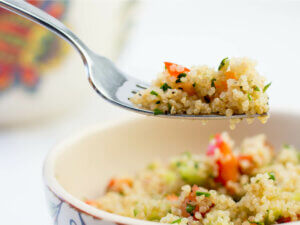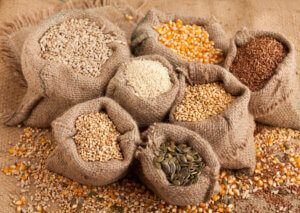Which Vegetables are High in Protein?

Fruits and vegetables are essential foods for everyone’s diet. They’re full of micronutrients that are important for the body’s functioning, whether an athlete or someone with a sedentary lifestyle. Everyone can enjoy the benefits. However, they can also contain high levels of macronutrients, as is the case of vegetables rich in protein.
Before we begin, it’s important to clear something up with regards to protein. The protein that comes from vegetables has a biologically inferior value to the protein that comes from animal products. In other words, it doesn’t contain all of the essential amino acids that the human body needs. In addition, its digestibility is lower, which can affect your metabolism.
For this reason, it’s not recommended for a person’s sole intake of protein to be via vegetable proteins. In the case that a person adopts a vegetarian or vegan diet, it’s recommended that they plan their diet with the help of a nutritionist.
Four vegetables rich in protein
Proteins are important nutrients to preserve the muscular function in the body. According to a study published in the journal Advances in Nutrition, a sedentary adult needs to consume more than eight grams of protein per kilogram of body weight every day.
This intake needs to dramatically increase in the case of athletes. In these cases, athletes are recommended to ingest up to three grams of protein per kilogram of body weight.
Guaranteeing an appropriate intake of protein is related to a lower risk of muscle mass loss, called atrophy. It’s also associated with illnesses that are related to lean tissue functioning.
The current scientific literature has managed to prove this association. This is demonstrated in a study published in Nutrients journal. All of the aforementioned reasons show why the consumption of the appropriate amounts of this nutrient is crucial. Here, we’ll tell you all about some of the vegetables that are highest in protein.
1. “Pseudo-cereals”
Quinoa and buckwheat contain high levels of protein. Their levels of this nutrient are significantly higher than that of other cereals and rice. However, the protein that it contains lacks at least one essential amino acid. Therefore, we recommend combining these foods with legumes or dried fruits in order to complete the amino acids.

In addition to being excellent sources of protein, pseudo-cereals are also rich in fiber. Fiber ensures correct intestinal function and reduces the risk of suffering from constipation.
2. Dried fruits
Dried fruits are excellent sources of protein as well as omega-3 fatty acids when consumed in high amounts. Therefore, they’re ideal foods to aid in maintaining the muscular function, controlling inflammation, and avoiding catabolism. They’re essential parts of the diet of both sedentary people as well as athletes.
However, you should also keep in mind that dried fruits are characterized by having a high caloric content. It’s not recommended to consume more than a handful at a time, since doing so can knock off your caloric balance and cause weight gain.
3. Legumes
Legumes are also protein-rich vegetables. However, to complete the benefit of this nutrient from legumes, you need to eat them with another food, such as a soy derivative. In this way, you can ensure that you’re getting all of the essential amino acids.
Legumes are also high in fiber and a good source of Vitamin B. They’re a fundamental food for ensuring intestinal health. In addition, they can be eaten and enjoyed in many different ways: hot, cold, in a salad, etc.
4. Seeds
In the last few years, it’s become popular to include seeds in your diet. Some popular options include chia seeds, flax seeds, and sesame seeds. These foods have high levels of protein and unsaturated fats such as omega-6.

Seeds can be added to almost any meal to increase its nutritional value. They’re full of minerals that can help you reach your micronutrient requirements. One of these essential minerals is zinc. According to a study published in the journal Nutrients, zinc is an important mineral to aid in the synthesis of testosterone in men.
Consume vegetables rich in protein
As you can see, it’s easy to add protein-rich vegetables into your diet. However, we recommend that you complement these foods with other animal proteins. This will ensure that you’re ingesting high-quality biologically rich nutrients that will guarantee muscular health.
Use the previously mentioned vegetables to accompany your dishes as a side dish or as a main course. In this way, you’ll increase the nutritional value of your meals and reduce your risk of becoming deficient in a certain micronutrient.
Finally, don’t forget that you’ll need to increase your protein intake if you play a sport or work out. It’s advisable to supplement your diet with a macronutrient. If you have more questions related to protein intake, don’t hesitate to reach out to a nutritional professional who can take a closer look at your diet and make recommendations accordingly!
Fruits and vegetables are essential foods for everyone’s diet. They’re full of micronutrients that are important for the body’s functioning, whether an athlete or someone with a sedentary lifestyle. Everyone can enjoy the benefits. However, they can also contain high levels of macronutrients, as is the case of vegetables rich in protein.
Before we begin, it’s important to clear something up with regards to protein. The protein that comes from vegetables has a biologically inferior value to the protein that comes from animal products. In other words, it doesn’t contain all of the essential amino acids that the human body needs. In addition, its digestibility is lower, which can affect your metabolism.
For this reason, it’s not recommended for a person’s sole intake of protein to be via vegetable proteins. In the case that a person adopts a vegetarian or vegan diet, it’s recommended that they plan their diet with the help of a nutritionist.
Four vegetables rich in protein
Proteins are important nutrients to preserve the muscular function in the body. According to a study published in the journal Advances in Nutrition, a sedentary adult needs to consume more than eight grams of protein per kilogram of body weight every day.
This intake needs to dramatically increase in the case of athletes. In these cases, athletes are recommended to ingest up to three grams of protein per kilogram of body weight.
Guaranteeing an appropriate intake of protein is related to a lower risk of muscle mass loss, called atrophy. It’s also associated with illnesses that are related to lean tissue functioning.
The current scientific literature has managed to prove this association. This is demonstrated in a study published in Nutrients journal. All of the aforementioned reasons show why the consumption of the appropriate amounts of this nutrient is crucial. Here, we’ll tell you all about some of the vegetables that are highest in protein.
1. “Pseudo-cereals”
Quinoa and buckwheat contain high levels of protein. Their levels of this nutrient are significantly higher than that of other cereals and rice. However, the protein that it contains lacks at least one essential amino acid. Therefore, we recommend combining these foods with legumes or dried fruits in order to complete the amino acids.

In addition to being excellent sources of protein, pseudo-cereals are also rich in fiber. Fiber ensures correct intestinal function and reduces the risk of suffering from constipation.
2. Dried fruits
Dried fruits are excellent sources of protein as well as omega-3 fatty acids when consumed in high amounts. Therefore, they’re ideal foods to aid in maintaining the muscular function, controlling inflammation, and avoiding catabolism. They’re essential parts of the diet of both sedentary people as well as athletes.
However, you should also keep in mind that dried fruits are characterized by having a high caloric content. It’s not recommended to consume more than a handful at a time, since doing so can knock off your caloric balance and cause weight gain.
3. Legumes
Legumes are also protein-rich vegetables. However, to complete the benefit of this nutrient from legumes, you need to eat them with another food, such as a soy derivative. In this way, you can ensure that you’re getting all of the essential amino acids.
Legumes are also high in fiber and a good source of Vitamin B. They’re a fundamental food for ensuring intestinal health. In addition, they can be eaten and enjoyed in many different ways: hot, cold, in a salad, etc.
4. Seeds
In the last few years, it’s become popular to include seeds in your diet. Some popular options include chia seeds, flax seeds, and sesame seeds. These foods have high levels of protein and unsaturated fats such as omega-6.

Seeds can be added to almost any meal to increase its nutritional value. They’re full of minerals that can help you reach your micronutrient requirements. One of these essential minerals is zinc. According to a study published in the journal Nutrients, zinc is an important mineral to aid in the synthesis of testosterone in men.
Consume vegetables rich in protein
As you can see, it’s easy to add protein-rich vegetables into your diet. However, we recommend that you complement these foods with other animal proteins. This will ensure that you’re ingesting high-quality biologically rich nutrients that will guarantee muscular health.
Use the previously mentioned vegetables to accompany your dishes as a side dish or as a main course. In this way, you’ll increase the nutritional value of your meals and reduce your risk of becoming deficient in a certain micronutrient.
Finally, don’t forget that you’ll need to increase your protein intake if you play a sport or work out. It’s advisable to supplement your diet with a macronutrient. If you have more questions related to protein intake, don’t hesitate to reach out to a nutritional professional who can take a closer look at your diet and make recommendations accordingly!
All cited sources were thoroughly reviewed by our team to ensure their quality, reliability, currency, and validity. The bibliography of this article was considered reliable and of academic or scientific accuracy.
- Wolfe RR., Cifelli AM., Kostas G., Kim IY., Optimizing protein intake in adults: interpretation and application of the recommended dietary allowance compared with the acceptable macronutrient distribution range. Adv Nutr, 2017. 8 (2): 266-275.
- Franzke B., Neubauer O., Cameron Smith D., Wagne KH., Dietary protein, muscle and physical function in the very old. Nutrients, 2018.
This text is provided for informational purposes only and does not replace consultation with a professional. If in doubt, consult your specialist.








